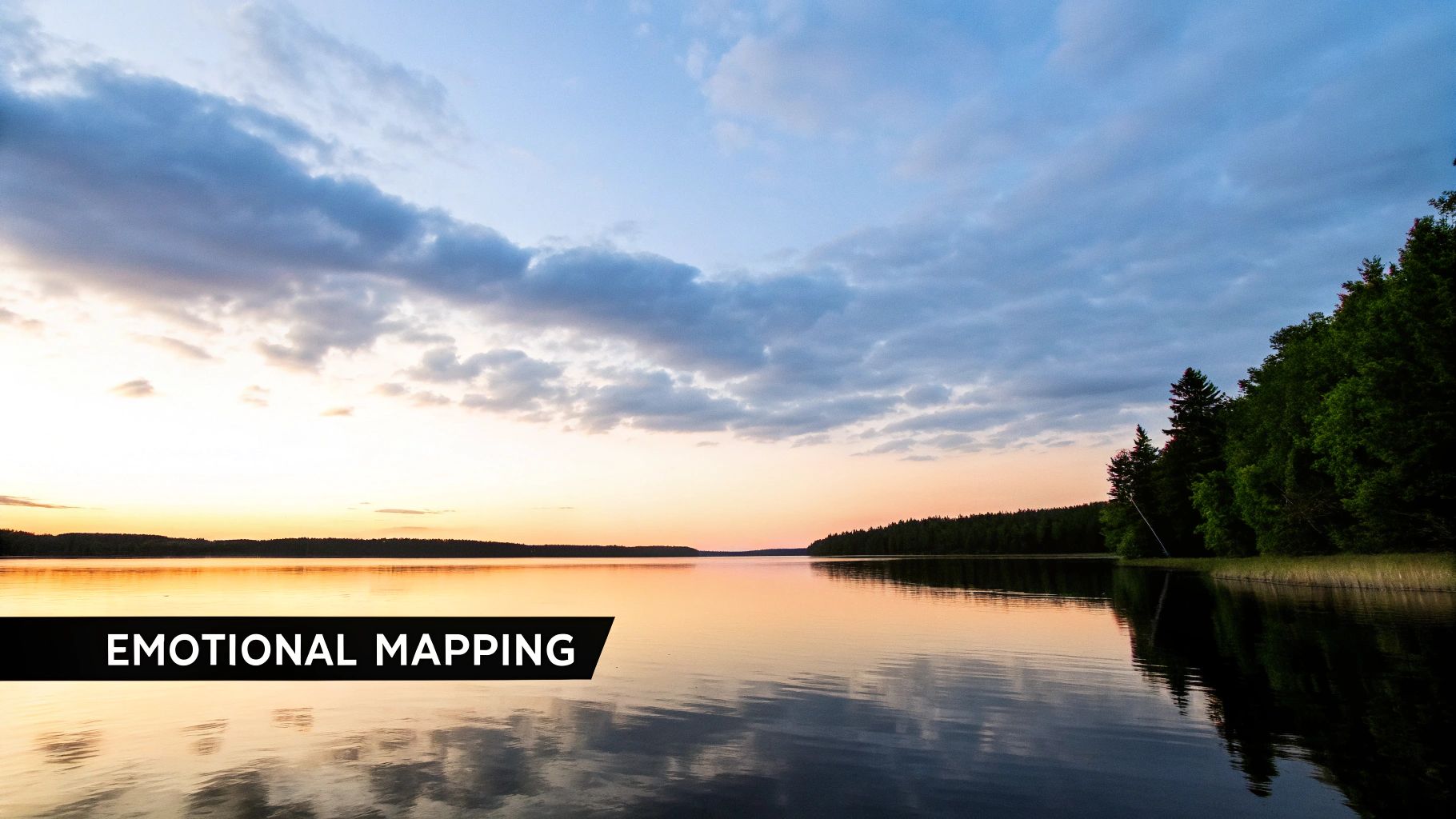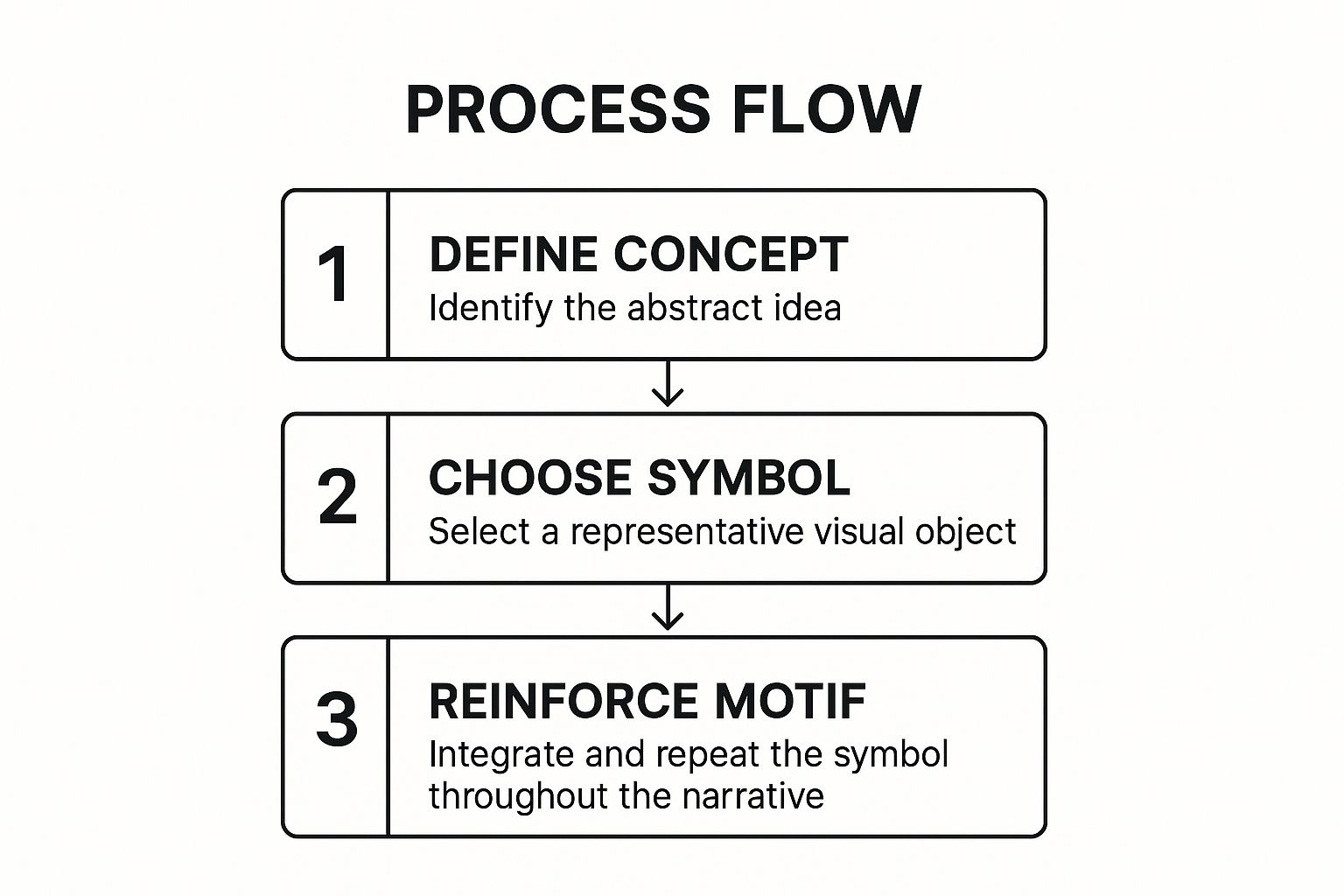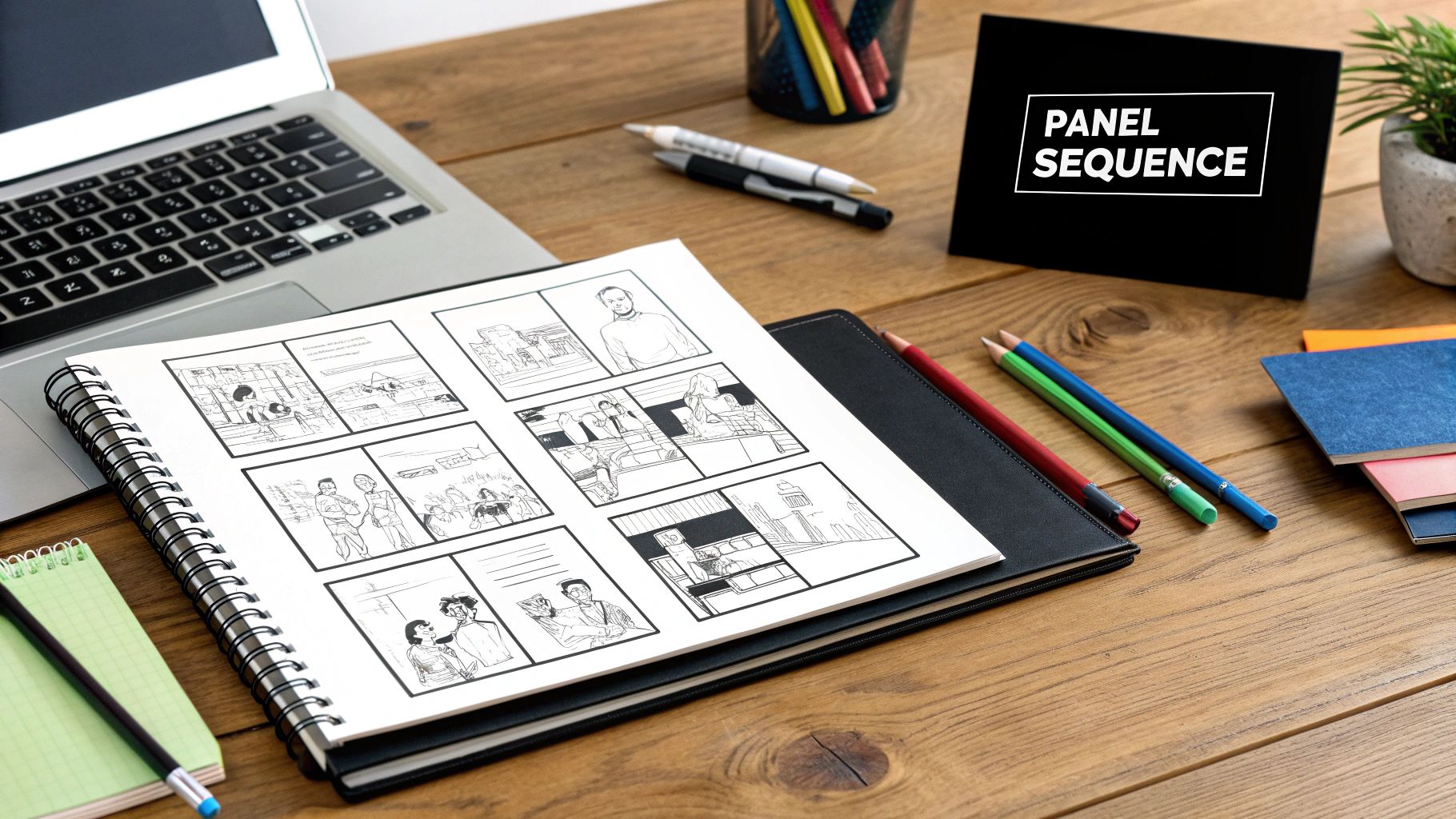Getting Started
Want to captivate your audience and leave a lasting impression? Visual storytelling techniques are key to crafting compelling narratives that resonate. This listicle provides a curated collection of eight powerful methods, each designed to elevate your visual communication across various platforms. Whether you're a startup, a freelancer, or a marketing agency, mastering these techniques will help you connect with your audience on a deeper level and achieve your communication goals. Why does this matter? Because visuals are processed faster than text, making visual storytelling a potent tool for engagement and memorability. To effectively use visual storytelling techniques, it's helpful to understand how to generally improve storytelling skills. This resource from Henri Den offers five simple steps to enhance your narrative abilities.
In this roundup, we'll explore practical, actionable visual storytelling techniques, moving beyond the basics to offer fresh perspectives and unique approaches. Learn how to weave compelling narratives using:
- The Hero's Journey Visual Arc: Structure your visual content around this classic narrative framework.
- Color Psychology: Evoke specific emotions and create atmosphere through strategic color use.
- Visual Metaphor and Symbolism: Add layers of meaning and intrigue through symbolic imagery.
- Sequential Visual Narrative: Tell stories through sequential art like comics and storyboards.
- Data Visualization: Transform raw data into engaging and informative visuals.
- Environmental Storytelling: Use setting and atmosphere to enhance your narrative.
- Character-Driven Visual Dynamics: Craft compelling characters that drive the visual story.
- Interactive and Immersive Storytelling: Engage audiences through interactive experiences.
Each technique is explained with real-world examples and practical tips for implementation, empowering you to immediately apply these concepts to your own projects. This listicle provides the tools you need to elevate your visual storytelling and achieve meaningful results.
1. The Hero's Journey Visual Arc
The Hero's Journey, a powerful visual storytelling technique, structures narratives around the archetypal transformation of a protagonist. This framework follows the classic monomyth structure, guiding the audience through emotional highs and lows using visual cues, lighting, and composition across three core acts: departure, initiation, and return. By mirroring this ingrained narrative pattern, visual storytellers can deeply resonate with audiences on a subconscious level. Learn more about The Hero's Journey Visual Arc and its application in marketing.

Examples in Action
From blockbuster films to impactful marketing campaigns, the Hero's Journey is a versatile visual storytelling technique. Consider these examples:
- Disney Classics: Films like The Lion King and Moana visually depict the hero's transformation through vibrant color palettes and symbolic environmental changes.
- Marvel Cinematic Universe: Origin stories like Iron Man showcase the hero's journey through visual representations of physical and emotional growth.
- Documentaries: Free Solo follows Alex Honnold's daunting climb, visually capturing his internal struggles and ultimate triumph.
- Brand Campaigns: Nike often employs the Hero's Journey to showcase athlete transformations, inspiring viewers through powerful visuals of overcoming challenges.
Implementing the Hero's Journey
Successfully applying the Hero's Journey requires careful consideration of visual elements. Here are actionable tips to make this technique work for your visual storytelling:
- Establish Visual Motifs: Introduce recurring visual elements early on that can evolve alongside the protagonist's journey, reflecting their growth and transformation.
- Environment as Reflection: Use changes in the environment to mirror the character's internal shifts, creating a visual metaphor for their progress.
- Visual Callbacks: Reinforce the cyclical nature of the journey by incorporating visual callbacks to the beginning during the return phase.
- Pacing and Rhythm: Vary the visual pacing and rhythm in each act to reflect the changing emotional intensity of the narrative. Fast-paced action sequences during the initiation contrast with slower, more contemplative shots in the departure and return.
- Focus on Transformation: Emphasize the visual transformation of the character rather than simply progressing the plot. Show, don't tell, the internal and external changes the hero undergoes.
This visual storytelling technique is particularly effective when aiming to create an emotional connection with the audience. By tapping into the universal themes of transformation and overcoming adversity, the Hero's Journey elevates visual narratives beyond simple plot progression and creates lasting impact.
2. Color Psychology and Emotional Mapping
Color Psychology and Emotional Mapping is a sophisticated visual storytelling technique that uses color palettes strategically to evoke specific emotions, guide narrative flow, and create subconscious associations. This approach involves carefully selecting and transitioning between colors to enhance storytelling, create mood, and influence audience perception without relying on dialogue or explicit narrative devices. By understanding the psychological impact of different hues, visual storytellers can manipulate color to elicit desired responses and deepen audience engagement.

Examples in Action
Many successful visual narratives leverage color psychology. Consider these examples:
- Wes Anderson Films: Known for highly stylized color palettes, Anderson uses distinct color schemes to create whimsical and nostalgic atmospheres.
- Instagram Aesthetics: The platform's shift from warm vintage filters to bright, saturated aesthetics reflects changing trends in visual communication.
- Branding: Coca-Cola's consistent use of red conveys energy, while Tiffany & Co.'s signature blue signifies luxury.
- The Matrix: The film uses green for the digital world and blue for reality, visually differentiating the two realms.
Implementing Color Psychology
Applying color psychology effectively requires planning and understanding. Here are actionable tips:
- Create a Color Script: Plan your color palette and transitions before production to ensure consistency and emotional impact.
- Temperature Shifts: Use color temperature (warm vs. cool) to indicate time progression or emotional changes.
- Limited Palette: Stick to 3-5 dominant colors to maintain visual cohesion and avoid overwhelming the viewer.
- Accessibility: Consider colorblindness and provide alternative visual cues for key information.
- Test and Refine: Check color combinations on different devices to ensure consistent display.
- Contrast for Focus: Employ color contrast to draw attention to key elements within the frame. Learn more about Color Psychology and Emotional Mapping and how it can be used to create effective logos.
This visual storytelling technique is particularly effective when aiming to create a strong emotional atmosphere or convey complex themes subtly. Color, when used strategically, can significantly enhance narrative impact and create a more immersive and memorable viewing experience. Color Psychology and Emotional Mapping is a powerful tool for visual storytellers seeking to engage their audience on a deeper emotional level.
3. Visual Metaphor and Symbolism
Visual metaphor and symbolism, a powerful visual storytelling technique, involves using visual elements to represent abstract concepts, emotions, or ideas beyond their literal meaning. This technique adds depth to visual narratives through symbolic imagery, metaphorical compositions, and archetypal representations that communicate complex themes without explicit explanation. In visual storytelling, color greatly influences emotional mapping, like the striking effect of a vibrant colored smoke plume. By tapping into shared cultural understanding and the power of visual association, this technique creates resonant and memorable narratives.
Examples in Action
Visual metaphors and symbolism appear across various media, enriching storytelling with layers of meaning:
- Branding: Apple's bitten apple logo symbolizes knowledge and innovation, instantly communicating the brand's core values.
- Art: Banksy's street art utilizes visual metaphors for social commentary, sparking dialogue and reflection.
- Film: Mirrors often represent duality or self-reflection, adding psychological depth to characters and narratives.
- Marketing: Dove's "Real Beauty" campaign uses diverse imagery to challenge conventional beauty standards, creating a powerful message of inclusivity.
- Historical Imagery: The broken chain symbolizes freedom in abolitionist movements, conveying a powerful message through a simple yet resonant visual.
Implementing Visual Metaphor and Symbolism
Successfully applying this technique requires careful planning and execution. Here are some actionable tips:
- Cultural Significance: Research the cultural significance of symbols within your target audience to ensure appropriate interpretation.
- Consistency: Establish the symbolic meaning early and reinforce it consistently throughout the narrative.
- Clarity: Balance subtlety with clarity to ensure comprehension without over-explanation.
- Enhance, Don't Replace: Use visual metaphors to enhance, not replace, clear storytelling.
- Originality: Create original symbolic systems for unique brand or story identity.
- Testing: Test metaphorical content with focus groups to ensure understanding and resonance.
The following infographic illustrates the three-step process for effectively using visual metaphors: Define the abstract concept you want to convey, choose a visual symbol to represent it, and reinforce this motif throughout your visual narrative.

This streamlined process emphasizes the importance of intentional symbol selection and consistent integration for maximum impact. Visual metaphor and symbolism is particularly effective when aiming to communicate complex ideas or evoke specific emotions on a deeper level. By layering meaning into your visual narrative, you create a richer and more engaging experience for your audience.
4. Sequential Visual Narrative (Comics/Storyboarding)
Sequential visual narrative, encompassing comics and storyboarding techniques, breaks down stories into individual frames or panels. This visual storytelling technique allows creators to meticulously control pacing, perspective, and information revelation through the arrangement and timing of visual elements. Similar to film editing but in a static medium, it empowers precise control over how viewers consume information and experience the narrative flow.

Examples in Action
Sequential visual narrative is a versatile technique applicable to various media. Here are some examples:
- Comics: Marvel and DC Comics utilize this technique to present complex superhero narratives, controlling the flow of action and dialogue within panels.
- Film Storyboarding: Pixar leverages storyboarding to pre-visualize animated films, meticulously planning each shot and transition.
- Digital Marketing: Instagram carousel posts and Stories employ sequential narrative to engage audiences with brand narratives.
- Infographics: Journalism and education often utilize infographic storytelling, combining visuals and text in a sequenced format.
Implementing Sequential Visual Narrative
Effectively using this visual storytelling technique involves understanding key principles:
- Vary Panel Sizes: Create visual rhythm and emphasis by alternating between large and small panels.
- 180-Degree Rule: Maintain spatial consistency and avoid viewer disorientation by adhering to the 180-degree rule.
- Transitions: Plan transitions between panels to ensure a smooth and logical narrative flow.
- Eye Movement: Consider natural eye movement patterns when arranging panels to guide the viewer's gaze.
- Strategic Shots: Utilize close-ups for emotional impact and wide shots to establish setting and context.
- Space for Imagination: Leave room for the audience's imagination between key moments, enhancing engagement.
Leveraging Sequential Visual Storytelling
This visual storytelling technique is particularly effective for controlling narrative pacing and building suspense. By strategically revealing information through carefully arranged visuals, creators can immerse audiences in the story and create a powerful sense of anticipation. Learn more about Sequential Visual Narrative (Comics/Storyboarding) and how to build a compelling creative portfolio showcasing this skill. Consider exploring visual storytelling techniques further to enhance your narrative impact.
5. Data Visualization Storytelling
Data visualization storytelling transforms complex data sets into compelling visual narratives. It reveals insights, patterns, and relationships through charts, graphs, interactive elements, and designed information hierarchies. This visual storytelling technique makes abstract or numerical information accessible and emotionally engaging while maintaining accuracy and clarity, bridging the gap between raw data and human understanding.
Examples in Action
Several successful examples highlight the power of data visualization storytelling:
- New York Times Election Results: Interactive visualizations allow users to explore election outcomes dynamically, understanding trends and patterns at national, state, and local levels.
- Spotify Wrapped: Personalized annual data stories engage users with their listening habits, presented through visually appealing charts and infographics.
- Hans Rosling's Presentations: Animated data presentations on global development effectively communicate complex trends over time, making statistics relatable and memorable.
- Financial Dashboards: Apps like Mint and Personal Capital use dashboards to provide users with clear visuals of their financial health, facilitating informed decision-making.
- COVID-19 Tracking Dashboards: Organizations like Johns Hopkins University utilized dashboards to communicate the spread and impact of the pandemic, providing critical information to the public.
Implementing Data Visualization Storytelling
Effectively using data visualization requires careful planning and execution. Here's how to make this visual storytelling technique work for you:
- Choose the Right Visual: Select visualization types (bar charts, line graphs, maps, etc.) that best represent the relationships within your data.
- Story-First Approach: Start with the story you want to tell, then find the data that supports it, ensuring a narrative-driven visualization.
- Consistency is Key: Maintain consistent color coding and labeling throughout your visuals to enhance clarity and comprehension.
- Contextualize Data: Provide context and benchmarks for data points so audiences can understand their significance.
- Test for Comprehension: Test your visualizations with your target audience to ensure they are easy to understand and interpret.
- Balance Detail and Simplicity: Strive for a balance between presenting detailed information and maintaining visual simplicity to avoid overwhelming the viewer.
This visual storytelling technique is particularly effective when dealing with complex data or when aiming to make abstract information more digestible. By transforming data into compelling narratives, you can engage audiences, enhance understanding, and drive meaningful insights. This approach elevates raw data from mere numbers to compelling stories that resonate with viewers.
6. Environmental and Atmospheric Storytelling
Environmental and Atmospheric Storytelling, a powerful visual storytelling technique, uses setting, mood, and environmental details to convey narrative information and emotional context without explicit exposition. This approach treats the environment as a character itself, using lighting, weather, architecture, and spatial relationships to communicate story elements and create immersive experiences for the audience. By carefully crafting the world around the subject, visual storytellers can evoke specific emotions, build tension, and enhance the narrative's impact.
Examples in Action
From dystopian futures to serene natural landscapes, environmental storytelling adds depth and meaning to visual narratives. Consider these examples:
- Blade Runner: The film's dark, rain-soaked cityscape reflects the dystopian themes of humanity and technology, creating a sense of unease and isolation.
- Studio Ghibli Films: Hayao Miyazaki's animated worlds, like the lush forests in Princess Mononoke or the whimsical seaside town in Kiki's Delivery Service, support ecological themes and evoke a sense of wonder.
- The Last of Us: This video game utilizes overgrown, post-apocalyptic environments to tell a story of survival and loss, with the decaying world reflecting the characters' emotional states.
- Apple Stores: The minimalist design and bright lighting of Apple Stores convey a sense of innovation and sophistication, aligning with the brand's image.
- Disney's Galaxy's Edge: This theme park land creates an immersive Star Wars experience by meticulously recreating the sights, sounds, and even smells of a galaxy far, far away.
Implementing Environmental Storytelling
Successfully using environmental storytelling requires careful consideration of visual elements. Here are actionable tips to make this technique work for your visual storytelling:
- Research and Reference: Study real-world locations and architectural styles to add authenticity and depth to your environments.
- Mood Enhancement: Employ weather and lighting to heighten emotional moments. A storm can symbolize conflict, while a sunset can represent peace or closure.
- Visual Contrast: Create clear visual distinctions between different story locations to reinforce narrative themes and character development.
- Reward Observation: Include details in the environment that reward close observation, adding layers of meaning and encouraging audience engagement.
- Spatial Awareness: Consider how audiences will move through and experience the space, ensuring that the environment enhances their journey.
- Stylized Realism: Balance realistic details with artistic stylization to best support the specific needs of your story.
This visual storytelling technique is particularly effective when aiming to create immersive and emotionally resonant experiences. By carefully crafting the environment, you can deepen audience engagement and strengthen the overall impact of your visual narrative.
7. Character-Driven Visual Dynamics
Character-Driven Visual Dynamics is a powerful visual storytelling technique that uses visual design to propel narratives and communicate complex character information without relying heavily on dialogue. This approach leverages character design, body language, facial expressions, and visual relationships between characters to convey personality, relationships, and character development. By prioritizing visuals, storytellers can create engaging narratives that resonate deeply with audiences on a visual and emotional level. Learn more about Character-Driven Visual Dynamics and its application in various media.
Examples in Action
Character-Driven Visual Dynamics is a versatile technique used across various media:
- Pixar Animation: Films like Inside Out and Toy Story masterfully use exaggerated body language and facial expressions to convey a wide range of emotions, even with non-human characters.
- Disney Villains: Classic Disney villains often feature angular shapes and dark color palettes, visually contrasting with the rounded, brighter designs of heroic characters.
- Fashion Photography: Model positioning, styling, and facial expressions communicate brand personality and create narratives within a single image.
- Political Cartoons: Caricature and exaggerated features communicate character traits and political stances quickly and effectively.
- Video Games: Character design in games like Overwatch and League of Legends utilizes distinct silhouettes and visual cues to convey character roles and personalities.
Implementing Character-Driven Visual Dynamics
Effectively using Character-Driven Visual Dynamics involves careful consideration of several visual elements:
- Shape Language: Utilize angular shapes for aggressive or villainous characters and rounded shapes for friendly or heroic characters.
- Signature Poses: Develop unique poses and gestures for main characters to reinforce their personalities and create visual recognition.
- Relationships Through Visuals: Show character relationships through proximity, eye contact, and body language. Close proximity and direct eye contact can indicate intimacy, while distance and averted gazes can suggest conflict.
- Costume and Color: Reinforce character development through costume and color choices. Changes in attire can reflect a character's internal transformation.
- Visual Contrast: Create visual contrast between opposing characters to emphasize their differences and heighten dramatic tension.
- Evolving Appearance: Allow characters' physical appearances to evolve alongside their emotional journeys. This could involve changes in posture, facial expressions, or even costume.
This visual storytelling technique is particularly effective when aiming to create compelling narratives with minimal dialogue. By focusing on visual cues, storytellers can communicate complex character information efficiently and effectively, allowing audiences to connect with characters on a deeper emotional level.
8. Interactive and Immersive Storytelling
Interactive and immersive storytelling represents a paradigm shift in visual storytelling techniques. This modern approach engages audiences as active participants, blurring the lines between narrative and experience. By leveraging interactive elements, virtual reality (VR), augmented reality (AR), and multimedia experiences, it breaks the traditional passive consumption model. Audiences can influence plotlines, explore 360° environments, or even step inside the narrative world, fostering deeper engagement and emotional connection.
Examples in Action
Several innovative projects demonstrate the power of interactive and immersive storytelling:
- Interactive Film/TV: Netflix's Black Mirror: Bandersnatch allowed viewers to make choices that directly impacted the story's progression, creating a personalized viewing experience.
- VR Journalism: The New York Times utilizes VR to immerse viewers in news stories, fostering empathy and understanding by placing them directly within the narrative environment.
- AR Gaming: Pokémon GO overlaid digital characters onto the real world, creating a location-based interactive narrative that encouraged exploration and social interaction.
- Social Media AR: Brands employ AR filters on platforms like Instagram and Snapchat to create interactive storytelling experiences, allowing users to engage with products and brand narratives in playful ways.
- Interactive Exhibits: Museums like the Anne Frank House use VR to provide immersive historical experiences, allowing visitors to connect with history on a more profound level.
Implementing Interactive and Immersive Storytelling
Successfully crafting these experiences requires a thoughtful approach to both narrative and technology. Consider the following:
- Story-First Approach: Begin by defining your story goals before selecting technology platforms. The technology should serve the story, not the other way around.
- User Journey Design: Plan for multiple user paths and choices while maintaining narrative coherence. Ensure a compelling experience regardless of the choices made.
- Intuitive Interaction: Provide clear interaction cues and design intuitive user interfaces to avoid frustrating the user. Learn more about Interactive and Immersive Storytelling and its design principles.
- Thorough Testing: Test your experience extensively across different devices and user capabilities to ensure accessibility and smooth functionality.
- Balanced Experience: Find the right balance between interactive elements and passive storytelling moments. Too much interactivity can become overwhelming, while too little can feel static.
- Technical Support: Plan for technical support and user assistance to address potential technical difficulties or user confusion.
This visual storytelling technique is particularly effective when aiming to create memorable and impactful experiences that resonate deeply with audiences. By allowing audiences to actively participate in the narrative, interactive and immersive storytelling fosters a sense of agency and ownership, transforming passive viewers into active participants.
Visual Storytelling Techniques Comparison Matrix
| Storytelling Technique | Implementation Complexity 🔄 | Resource Requirements ⚡ | Expected Outcomes 📊 | Ideal Use Cases 💡 | Key Advantages ⭐ |
|---|---|---|---|---|---|
| The Hero's Journey Visual Arc | Medium to High 🔄🔄 | Moderate to High ⚡⚡ | Strong emotional connection and clear arc 📊⭐ | Narrative films, brand campaigns, transformational stories | Universally recognizable structure, natural climax points |
| Color Psychology and Emotional Mapping | Medium 🔄 | Moderate ⚡ | Immediate emotional impact, mood setting 📊 | Branding, film stylization, UI/UX design | Cross-cultural emotional cues, subtle narrative guidance |
| Visual Metaphor and Symbolism | Medium 🔄 | Low to Moderate ⚡ | Deep layered meaning and intellectual engagement 📊⭐ | Artistic campaigns, symbolic branding, social commentary | Adds richness, enables layered interpretation |
| Sequential Visual Narrative | High 🔄🔄🔄 | Moderate to High ⚡⚡ | Precise pacing and active audience engagement 📊 | Comics, storyboards, social media narratives | Tight narrative control, adaptable format |
| Data Visualization Storytelling | High 🔄🔄 | High ⚡⚡ | Clear insights and data-driven decisions 📊⭐ | Journalism, business dashboards, educational content | Makes complex data understandable, builds credibility |
| Environmental and Atmospheric Storytelling | High 🔄🔄🔄 | High ⚡⚡⚡ | Immersive worlds with emotional and narrative depth 📊 | Films, games, experiential design | Immersion, subtle information delivery |
| Character-Driven Visual Dynamics | Medium to High 🔄🔄 | Moderate ⚡ | Strong emotional connection and character clarity 📊⭐ | Animation, gaming, fashion, political cartoons | Efficient character communication, cross-cultural appeal |
| Interactive and Immersive Storytelling | Very High 🔄🔄🔄🔄 | Very High ⚡⚡⚡⚡ | Highly engaging, personalized user experiences 📊 | VR/AR experiences, interactive media, gaming | Personalized narratives, viral potential |
Final Thoughts
This exploration of visual storytelling techniques has revealed the power of imagery to communicate, persuade, and inspire. From harnessing the emotional resonance of color to crafting compelling character-driven narratives, each technique offers unique avenues for connecting with your audience on a deeper level. We've examined diverse approaches, including the hero's journey, visual metaphors, data visualization, and the immersive potential of interactive experiences. Mastering these techniques allows you to transform ordinary content into captivating stories that resonate with your target audience.
Bringing it All Together
Effective visual storytelling isn't about randomly applying these techniques. It's about strategically weaving them together to create a cohesive and impactful narrative. Think about how color psychology can enhance the emotional impact of a character's journey, or how data visualization can strengthen the message conveyed through a visual metaphor. The true power lies in the synergy created when these techniques work in harmony.
Key Takeaways and Next Steps
Let's recap some of the most important takeaways to consider as you embark on your visual storytelling journey:
- Intentionality: Every visual element should serve a purpose. Ask yourself: What story am I trying to tell, and how does this element contribute to the overall narrative?
- Audience Focus: Understand your target audience's visual language and tailor your approach accordingly. What resonates with one audience might not work for another.
- Experimentation: Don't be afraid to try new techniques and combinations. The more you experiment, the better you'll understand what works best for your brand and message.
- Consistency: Maintain a consistent visual style across your various platforms. This reinforces brand recognition and creates a cohesive experience for your audience.
As you refine your approach to interactive narratives, consider further exploring mastering interactive storytelling to engage, immerse, and captivate your audience. These tips offer valuable insights into leveraging interactive elements to enhance your storytelling.
The Power of Visual Storytelling
In today's visually saturated world, mastering visual storytelling techniques is no longer a luxury, but a necessity. Whether you're a small business owner, a marketing professional, or a creative freelancer, the ability to communicate effectively through visuals can significantly impact your success. By weaving compelling narratives that resonate with your audience, you can forge deeper connections, build stronger brand loyalty, and ultimately achieve your communication goals.
Elevate your visual storytelling with Creativize, a platform designed to help you create stunning visuals and bring your stories to life. Creativize offers a range of tools and resources that empower you to implement the techniques discussed in this article, from color palettes and image libraries to interactive design elements.

